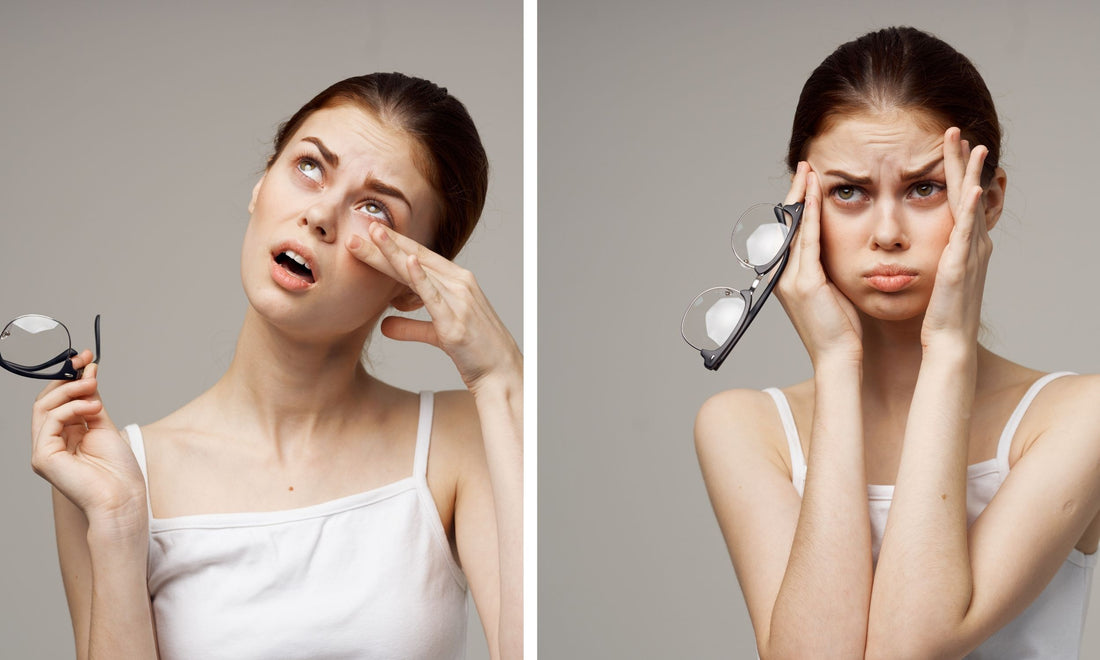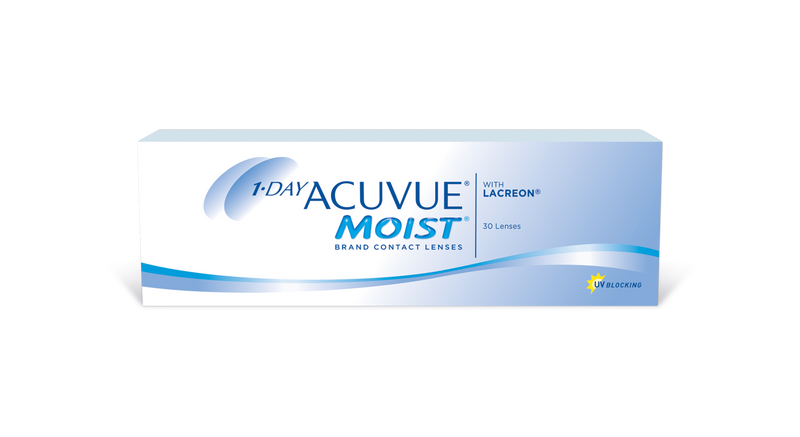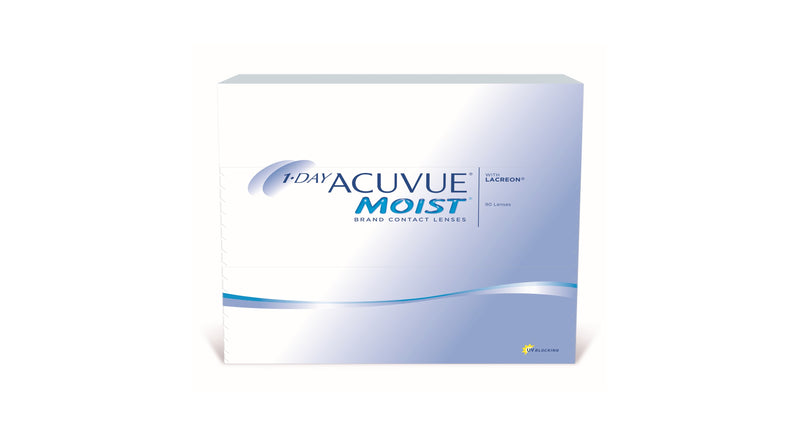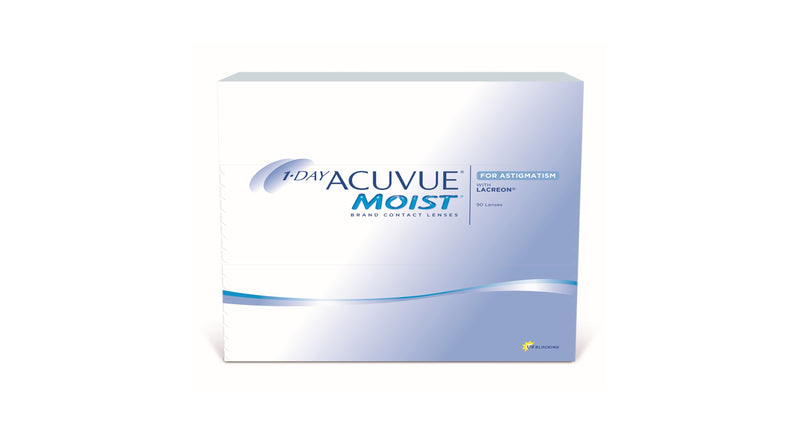
What is Astigmatism?
Share
If you or anyone you know wears glasses or contact lenses, it’s likely you’ve heard the term astigmatism mentioned before in some way, shape, or form – but what does it mean? You have probably already deduced that it has something to do with eyesight, but you might not be familiar with the definition of astigmatism. In this blog post, we’ll not only discuss what astigmatism is, but we’ll also take a look at some of the causes, symptoms, treatment options, as well as misconceptions of astigmatism.
While it might sound scary like some sort of a disease, astigmatism is actually a common vision condition resulting from an imperfect curvature of the eye. In a perfectly shaped eye, which is circular like a ball, light enters the eye and is bent or refracted evenly in all directions. But when either the curvature of the cornea or the curvature of the lens is more oval than it is circular, the light is refracted unevenly, making it more difficult for your eye to focus. When the curvatures of the eye are misaligned, it can also result in blurred or distorted vision of objects both near and far.

The cornea is the front surface of the eye and the lens is on the inside. If the curvature of your cornea is the culprit, you have what is called corneal astigmatism. If it’s the curvature of your lens that is affecting your vision, you have what is known as lenticular astigmatism. This imperfection in the way the eye bends light rays is known as a refractive error. Two other common examples of refractive errors are nearsightedness (myopia) and farsightedness (hyperopia). Nearsightedness is when objects in the distance appear blurry and farsightedness is when objects that are closer appear blurry. It is common for someone who has astigmatism to also be affected by either nearsightedness or farsightedness.
Causes of Astigmatism
While we understand what factors result in astigmatism, we honestly don’t know what causes it in the first place. As mentioned above, astigmatism is a result of the cornea or the lens being shaped more like an oval than a circle. Both the cornea and lens are largely responsible for focusing inbound light reaching the eyes, helping to focus light rays properly on the retina. Small variances, often present at birth, in the alignment of these two important parts of the eye can lead to astigmatism. An eye injury or eye surgical procedures may also result in astigmatism. Individuals with astigmatism may also experience other refractive errors, such as blurred vision at near and far distances due to light rays not refracting properly onto the retina.

In some rare instances keratoconus, a condition where the cornea becomes thinner over time and bulges outward into a cone shape, can cause astigmatism. In these cases, contact lenses would be required to effectively counteract the astigmatism because glasses would not be helpful.
Astigmatism can occur in both children and adults, but the risk is higher if you have a family history of astigmatism or keratoconus. Anything that causes thinning of your cornea is also likely to result in this refractive error. Severe nearsightedness and farsightedness also increases the chance of someone having astigmatism.
Astigmatism Symptoms and Blurred Vision
Let’s take a look at some astigmatism symptoms. The first and most common symptom of astigmatism is blurred vision or distorted vision. Blurry vision can affect your ability to see at all distances and may cause difficulty in seeing at night. Described by some as sort of a double vision, the blurriness can vary in severity and may not always affect both eyes equally. If minor, you may not even detect any anomalies with your eyesight. Who knows, you might have astigmatism and not even know it!

Eyestrain and/or eye discomfort are also symptoms commonly associated with astigmatism. As a result of the eyes working harder to focus on various objects, astigmatism can lead to headaches and squinting as well. People with astigmatism are also known to suffer from poor night vision. That being said, the presence of these symptoms is not always a definite sign of astigmatism so you should consider consulting with an eye health care specialist or optometrist to complete an eye exam.
Diagnosing Astigmatism
If you’re experiencing symptoms of astigmatism or are just anxious about whether you have it or not, don’t worry! To diagnose astigmatism is as easy as scheduling an eye exam with an optometrist or ophthalmologist. If you’ve ever had an eye exam in the past, it’s likely that you’ve already been tested for astigmatism. If you’re scheduling an eye exam for the first time, however, it might feel nerve-wracking. After all, the eyes are a sensitive part of your body and the thought of having machines near them can be a bit intimidating.

Rest assured, there's nothing to fear. To test for astigmatism the optometrist will guide you through a typical eye exam, also used to diagnose nearsightedness or farsightedness. In addition to checking your general eye health, the eye exam will consist of a series of tests to evaluate how your eyes focus and how they receive or refract light. Various slides, lights, and other machines will be used to gather necessary information about your vision. Completing an eye exam will allow the optometrist to guide you through the next steps and, if necessary, recommend the proper astigmatism treatment options. Conducting routine eye exams is crucial to maintaining good eye health and catching and treating any issues before they worsen.
Preventing Astigmatism
Unfortunately, there is no real method of preventing astigmatism. It is often found that astigmatism is already present at birth or in early childhood and is a genetically inherited trait. It is also possible for astigmatism to develop after an eye injury or surgery.
While there is not known prevention of astigmatism, treating astigmatism can prevent the development of other vision complications. One such complication is what's known as a “lazy eye” or amblyopia. When astigmatism isn't treated in one eye, it causes the brain to favour the other “stronger” eye. In doing so, vision impairment and loss of depth perception can occur.

Common Misconceptions Surrounding Astigmatism
Some common misconceptions surrounding astigmatism revolve around activities such as reading in poor lighting or sitting too close to the television or computer screen. While these activities can contribute to eye strain, they will not cause or worsen astigmatism. There are activities that you can complete, such as conscious blinking exercises, to help reduce eye strain and help with overall eye health. Another question you might have is whether wearing glasses with the incorrect prescription can worsen your astigmatism. Luckily, the answer is no. That being said, wearing the incorrect prescription can also result in headaches and eye strain.
Astigmatism in Children
As mentioned earlier, it's often discovered that astigmatism is present at birth or that it develops during childhood so it is important to schedule regular eye exams with an optometrist for your infant. It is not uncommon for babies to be born with astigmatism. While in many cases the astigmatism will disappear naturally within a year, it can sometimes carry on into adulthood. Children will often have difficulty realizing or describing issues with their vision because they have no point of reference. For example, if they suffered from astigmatism since birth, they wouldn't know what astigmatism-free vision looks like and may not comprehend the blurriness in their eyesight. If left unchecked, the astigmatism can cause headaches and other issues that could potentially hinder a child's performance at school.

Astigmatism Treatment
If after completing your eye exam the optometrist diagnoses you with astigmatism, they will also provide you with their professional recommendation on how to treat it. Astigmatism treatments work to improve clarity and focus in your vision as well as reduce eye strain. If your astigmatism is minor and you don't have any other vision problems or refractive errors, your optometrist might not even think any treatment is necessary. Astigmatism is otherwise usually very easily treated with corrective lenses, which can mean either glasses or contact lenses. Another option for treating astigmatism is through refractive surgery.
Corrective Lenses
Astigmatism glasses are fitted with lenses that bend light into your eye in such a way that it counteracts the imperfect shape of your eyes. This allows for the light entering your eye to ultimately be distributed evenly. Glasses are a reliable, solid choice for treating astigmatism. Not only are they easy to wear, they can be fitted to various stylish shapes and fashionable frames. There is definitely a pair of glasses out there to suit anybody's taste.

Depending on the severity of the astigmatism, there are a couple of options available when it comes to contact lenses. There are soft daily disposable contacts known as toric lenses or there are more rigid, gas permeable contact lenses used for a procedure called orthokeratology. Your optometrist will know which corrective lens is best suited for treating your astigmatism, whether it be glasses or contact lenses.
Orthokeratology
Mentioned briefly above, another treatment option for astigmatism is a procedure called orthokeratology, also known as corneal refractive therapy. This procedure involves wearing specially fitted gas permeable contact lenses overnight. While sleeping, the orthokeratology contact lenses gently reshape the cornea, resulting in improved eyesight the next day. This form of treatment is best suited for patients with a low level of astigmatism. As the orthokeratology contact lenses are only intended to be used during the night, they don't need to be worn during the day. People undergoing the orthokeratology procedure will need to continue using the gas permeable contact lenses in order for it to work. Ceasing to wear the orthokeratology lenses at night will unfortunately return your vision to how it was before starting the procedure.
Refractive Surgery
Another form of astigmatism treatment is refractive surgery. This method is appealing to many because it improves vision and also eliminates the need for glasses or contact lenses. There are various forms of refractive surgery, but most involve the use of a laser to correct the curvature of your eye. Some of the techniques used in refractive surgeries include flap procedures, surface procedures, and corneal incision procedures.

As with all surgeries, your doctor will need to evaluate whether you're a good candidate to receive the treatment. There are many different types of refractive surgeries, including but not limited to: LASIK (Laser-assisted in-situ keratomileusis), LASEK (Laser-assisted subepithelial keratectomy), FLEx (Femtosecond Lenticule Extraction), and SMILE (Small Incision Lenticule Extraction).
A lot of the time, people will use the term “LASIK” interchangeably to encompass all forms of refractive surgery. That being said, LASIK is the most common choice as a treatment for refractive errors such as astigmatism, nearsightedness, and farsightedness. LASIK in particular involves an ophthalmologist using a laser to reshape the cornea to improve eyesight.
A lot of the time, people will use the term “LASIK” interchangeably to encompass all forms of refractive surgery. That being said, LASIK is the most common choice as a treatment for refractive errors such as astigmatism, nearsightedness, and farsightedness. LASIK in particular involves an ophthalmologist using a laser to reshape the cornea to improve eyesight.
Finding an Optometrist
Now that we've gone over the causes, symptoms, and treatment options available for astigmatism, hopefully you have a better idea of what this refractive error is all about. The next step is to book an eye exam with an optometrist. If you're looking for an eye exam clinic in Vancouver, or specifically in Surrey, feel free to book an appointment with us at Look Optometry and we'll gladly take care of you. We have some of Surrey's best optometrists and are proud to be rated Surrey's #1 optometry clinic.
We do much more than just eye exams – if it turns out that you need to see an eye specialist or need laser eye surgery consultation, we know the best ophthalmologists in Surrey and can point you in the right direction.
Don't be shy and don't delay. Your eyes are extremely important and it's crucial to routinely complete eye exams in order to monitor any changes to your eye health as you age. Again, please feel free to book an appointment with us, give us a call, or visit us in store. We look forward to meeting you – see you soon!
















